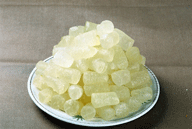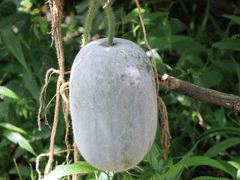Goa is abuzz with excitement as vintage bike and car owners, users, collectors and fans are decking […]

I FOUND PETHA!
Life & Living, Mar 20- Mar 26, 2021 March 19, 2021The famous petha of Agra and Taj Mahal fame… created by Moghul chefs for Shahanshah Jahangir! The sweet is from the ash gourd which is perceived as one of the nutritious vegetables of India. The original misty white petha has gone in to various avatar today with different flavours as seen below… shahi angoor petha, coconut petha, paan petha, santra petha, kesar elaichi petha, cherry mango petha, etc. Nothing to beat the flavour of original petha though!
By Tara Narayan
OF COURSE I blinked and took a second and third look. Last week at one of the supermarkets I found petha and don’t ask me why, I was thrilled. It is very silly of me of course! Once some months ago I’d seen these petha packets at the petrol pump Magsons branch in Panaji but that time although I wanted to buy it, I didn’t buy it, thinking so much rotten sugar da da da…have I lost it that I want to buy it, etcetera.
A lot of sanctimonious stupidity for later on I returned several times to enquire if a new lot of petha had arrived, I wanted it to buy it for a friend! The Magsons girls looked pitifully at me and wondered why I didn’t buy it when it was there! Are they expecting more stocks? Probably not for don’t I know this is covid times! True. Imagine missing out on the first opportunity and then looking for it again and again like I’d lost a pair of diamond earrings or something equivalent (as a matter of fact long, long years ago I’d lost a pair of diamond earrings while bussing it out to work in Mumbai that was Bombay then in the 70s), but this is about petha!
I do have a real soft corner for petha. And since it was on my mind last week, there it was in these pleasing blue Haldiram boxes at the Goa Hypermarket in Taleigao and I couldn’t believe my eyes. It was petha and this time I firmly bought a box (Rs 90) wondering fleetingly if I should have bought the remaining boxes too in case they’re not there if I come back for them.
Now ask me what is this petha I’m so excited about. I’m referring to these soft misty sweet chunks which the city of the Taj Mahal is famous for. It’s become a quintessentially north eastern sweet and I’m sure it has a Persian history…the story goes that it was Emperor Shahjehan who on a bored hot summer day asked his chefs to come up with a sweet to match the cooling looks of his favorite mausoleum the Taj Mahal, which he built in memory of his late wife Mumtaj Mahal (who died giving birth to her 14th child, a daughter, Gauhar Begum, who interestingly lived to a ripe old 85 years – while her mother had gone with the wind in 38 years, such are the ironies of life). To go on with the story the emperor’s chefs created petha to cool his nostalgia or something like that.
PETHA, of course, was much loved and it soon became the sweet of Agra which nobody who knows it failing to buy some of it from the market place. Almost sweetmeat halwai sells petha and now of course with commercialization setting in the sweet has gone into several variations…as in kesar petha, angoori petha, rose petal petha, ladoo petha, endless nonsense!
I’m just sentimental about my original austere translucently white petha chunks. The good ones are not cloying sweet to kill the tastebuds. I can wax lyrical about petha made from the juice of the ash gourd or vine white gourd or “raakh laukhi” (or kumhado, kushimand, boodido gummodi in Telugu, neer pooshnikkai in Tamil, kumbalam in Malalyalam …botanically Benincasa hispida). The ingredients are just ash gourd flesh, sugar, alum and lime juice and the eventual icy looking chunks are crustily firm without but uniquely sweetly soft within– bite into them and ooooh, taste a burst of sweetness to live for or die which fills and cools the senses! Those flavored with saffron or natural rose extract are also delicious and I believe nowadays one may also find betal paan leaf petha as also almond-enshrined petha, haven’t tasted them.
One may put petha chunks to good use sliced or chopped or grated in veggie raita or extended sweets, whip a petha nugget into a lassi, buttermilk or whatever. Experiment to find your sublime combo if you wish. I haven’t done it yet, I don’t know. Until last week I’d lost touch with petha long years ago and have just rediscovered them anew!
Come to think of it the petha has become the familiar sweet of the north and especially the Agra-Mathura-Barsana beat where once upon a time my favorite feminist god Krishna Kannaiya roamed and dallied with the village girls including Radha…no, of course not, I don’t think Lord Krishna knew the charms of petha! Remember it’s a Moghul time treat creates to lull the nostalgia of an emperor for his wife!
I hate 99% sweets but the one percent I will stay awake for includes Agra’s petha! I am addicted to the misty white chunks of misty petha. I dare say one may chill the chunks before enjoying although they may become crustier like candy. If one wishes one may even slice them thin or grate them into strands before lingering over the charms of ash gourd petha. Not bottle gourd petha but ash gourd petha. Bottlegourd may be used to adulterate the original temptation…maybe even gelatin is used. We live in such corrupt times, there’s no respect or sanctity of anything!
YOU must know the ash gourd is one vegetable which enjoys super food status. Even Sadhguru Jaggi Vasudeva’s kitchen at the Isha Foundation in Coimbatore promotes ash gourd recipes. One may find ash gourds in plenty in the Goan local market and they’re the most expensive gourd going at Rs100 plus, plus. Reportedly, petha made from ash gourd is brain food and in Ayurveda tradition one is encouraged to drink ash gourd juice on an empty stomach in the morning for all kinds of blessings to descend on one. There is also a winter melon but it’s lake green in color and not dusty ash grey – the Chinese and Japanese are crazy about these gourds!

At Sadhguru Jaggi Vasudeva’s Isha Foundation located on the outskirts of Coimbatore in south India, they love the ash gourd (also called the winter melon). From the sound of it this is one sacred gourd and the vegetable to indulge in come the summer months. Nobody is quite sure where the ash gourd comes from but it features in ancient Chinese literature of the 5th and 6th century.
Sadhguru says that the ash gourd is a very auspicious vegetable and in the old days people were advised to hand an ash gourd outside their home to invite good energies! In Ayurveda the ash gourd is perceived as a vegetable with high levels of prana or vital life energy….so call it what you will, bring the ash gourd home to feature in your home fare. In Sanskrit the ash gourd is called the kushmanda.
Sadhguru’s kitchen advises we drink a glass of ash gourd juice in the morning to enhance intelligence, sharpness of mind and calm the nerves. Make a modestly spiced sabzi out of it or a raita or a sherbet sweetened with honey….eating the ash gourd can take care of constipation, piles, boils and much else bothering body beautiful. A cautionary note: the ash gourd vegetable is said to create too much coolness or sheeta in the bodily system, so if one is susceptible to colds, asthma, sinusitis, be careful and don’t over-indulge in kushmanda foods!
If you check out isha.sadhguru.org you will find much more researched material on the ash gourd of life!
We in India have petha which became one of my favorite sweets something like 30 years ago. I had discovered petha and bal kakdi (long tendril like tender cucumbers) while roaming around Agra, Mathura, Barsana many years ago in my junketing around Indiain my 30s. And yes, despite the sugar I’ll have you know that petha is considered a healthy sweet to consume and if you read your Ayurveda this vegetable is seen as the cooling vegetable of summer time and so is the sweet of petha a cooling sweet to relish. Generally, speaking the ash gourd is seen as a super alkalinizing gourd.
Which reminds long years ago my friends Jerome and Anasasia Mendes had taught me how to cube ash gourd, boil in water, mash and sieve it and drink the juice first thing in the morning on an empty stomach for ultimate wellbeing. Some say one must drink without boiling ash gourd…just grate, squeeze juice and make it palatable with lemon juice, may be pinch hing or asafetida…and cheers. It’s certified anti-diabetic, anti-carcinogenic and everything else good and Jerome and Ana said they were living proof of this! Oh, I so miss these two friends, they’re lost somewhere in London and I’ve lost touch with them.
Interestingly, in up north India many a pregnant woman is indulged with sweet petha if they’re feeling wistful or whimsical! It seems a few petha chunks can unblock a bout of constipation….and yeah, I would serve petha as a royal sweet to savor after dinners instead of the best bitter sweet chocolate! I would say petha is a health-conscious sweet despite the sugar. So go get yourself some petha these hot March days…and if you know more about the ash gourd do let me know, so that I may share it here. You may of course make your own petha at home but get your ash gourd from an organic farm.
How to make your own petha at home ….
TAKE 1 kg ash gourd (petha); 750 kg sugar; 1 tsp alum powder; 1 tbs lemon juice.
NOW cut petha into half, remove skin and seeds and cut into chunks. Prick them with a fork and put pieces in a large pan, cover with sufficient water. Add alum powder and bring to a boil for about ten to 15 minutes. Remove from heat, drain in running water. Set aside.
Separately combine sugar in a cup or two of water and heat till sugar dissolves. Add lemon juice to remove unwanted scum. Reduce heat to medium and add in the cooked petha. Continue cooking till petha chunks are softened and sugar syrup is of three-thread consistence. Remove petha pieces separately and let them set so that they do not stick together. Serve cool or as you wish! For example, if you’re making a Delhi-styled faloodo you may use sliced petha instead of malai or kesar kulfi!














